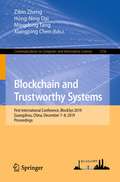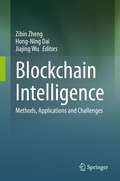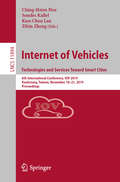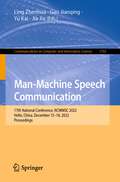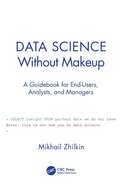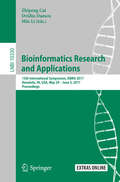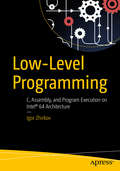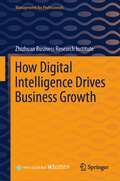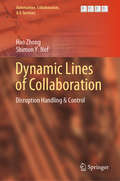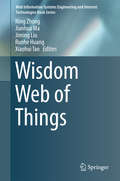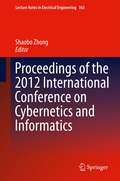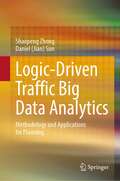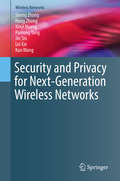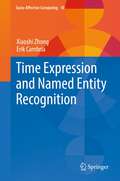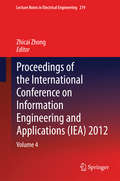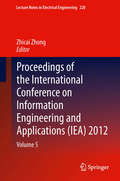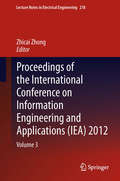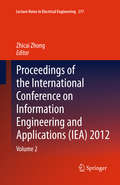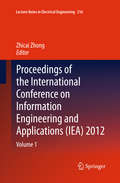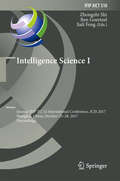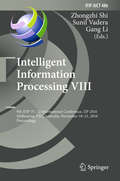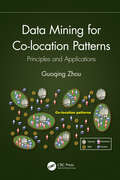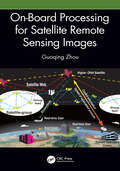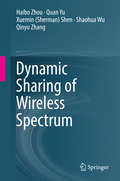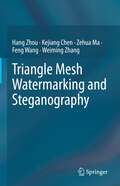- Table View
- List View
Blockchain and Trustworthy Systems: First International Conference, BlockSys 2019, Guangzhou, China, December 7–8, 2019, Proceedings (Communications in Computer and Information Science #1156)
by Zibin Zheng Hong-Ning Dai Mingdong Tang Xiangping ChenThis book constitutes the thoroughly refereed post conference papers of the First International Conference on Blockchain and Trustworthy Systems, Blocksys 2019, held in Guangzhou, China, in December 2019.The 50 regular papers and the 19 short papers were carefully reviewed and selected from 130 submissions. The papers are focus on Blockchain and trustworthy systems can be applied to many fields, such as financial services, social management and supply chain management.
Blockchain Intelligence: Methods, Applications and Challenges
by Zibin Zheng Hong-Ning Dai Jiajing WuThis book focuses on using artificial intelligence (AI) to improve blockchain ecosystems. Gathering the latest advances resulting from AI in blockchain data analytics, it also presents big data research on blockchain systems.Despite blockchain's merits of decentralisation, immutability, non-repudiation and traceability, the development of blockchain technology has faced a number of challenges, such as the difficulty of data analytics on encrypted blockchain data, poor scalability, software vulnerabilities, and the scarcity of appropriate incentive mechanisms. Combining AI with blockchain has the potential to overcome the limitations, and machine learning-based approaches may help to analyse blockchain data and to identify misbehaviours in blockchain. In addition, deep reinforcement learning methods can be used to improve the reliability of blockchain systems.This book focuses in the use of AI to improve blockchain systems and promote blockchain intelligence. It describes data extraction, exploration and analytics on representative blockchain systems such as Bitcoin and Ethereum. It also includes data analytics on smart contracts, misbehaviour detection on blockchain data, and market analysis of blockchain-based cryptocurrencies. As such, this book provides researchers and practitioners alike with valuable insights into big data analysis of blockchain data, AI-enabled blockchain systems, and applications driven by blockchain intelligence.
Internet of Vehicles. Technologies and Services Toward Smart Cities: 6th International Conference, IOV 2019, Kaohsiung, Taiwan, November 18–21, 2019, Proceedings (Lecture Notes in Computer Science #11894)
by Zibin Zheng Ching-Hsien Hsu Sondès Kallel Kun-Chan LanThis book constitutes the proceedings of the 6th International Conference on the Internet of Vehicles, IOV 2019, which took place in Kaohsiung, Taiwan, in November 2019. The 23 papers presented in this volume were carefully reviewed and selected from 101 submissions. The papers focus on providing new efficient solutions with digital intervehicular data transfer and overall communications. Yet, IOV is different from Telematics, Vehicle Ad hoc Networks, and Intelligent Transportation, in which vehicles like phones can run within the whole network, and obtain various services by swarm intelligent computing with people, vehicles, and environments.
Man-Machine Speech Communication: 17th National Conference, NCMMSC 2022, Hefei, China, December 15–18, 2022, Proceedings (Communications in Computer and Information Science #1765)
by Ling Zhenhua Gao Jianqing Yu Kai Jia JiaThis book constitutes the refereed proceedings of the 17th National Conference on Man–Machine Speech Communication, NCMMSC 2022, held in China, in December 2022.The 21 full papers and 7 short papers included in this book were carefully reviewed and selected from 108 submissions. They were organized in topical sections as follows: MCPN: A Multiple Cross-Perception Network for Real-Time Emotion Recognition in Conversation.- Baby Cry Recognition Based on Acoustic Segment Model, MnTTS2 An Open-Source Multi-Speaker Mongolian Text-to-Speech Synthesis Dataset.
Data Science Without Makeup: A Guidebook for End-Users, Analysts, and Managers
by Mikhail Zhilkin"Having worked with Mikhail it does not surprise me that he has put together a comprehensive and insightful book on Data Science where down-to-earth pragmatism is the recurring theme. This is a must-read for everyone interested in industrial data science, in particular analysts and managers who want to learn from Mikhail‘s great experience and approach." --Stefan Freyr Gudmundsson, Lead Data Scientist at H&M, former AI Research Lead at King and Director of Risk Analytics and Modeling at Islandsbanki. "It tells the unvarnished truth about data science. Chapter 2 ("Data Science is Hard") is worth the price on its own—and then Zhilkin gives us processes to help. A must-read for any practitioner, manager, or executive sponsor of data science." --Ted Lorenzen, Director of Marketing Analytics at Vein Clinics of America "Mikhail is a pioneer in the applied data science space. His ability to provide innovative solutions to practical questions in a dynamic environment is simply superb. Importantly, Mikhail’s ability to remain calm and composed in high-pressure situations is surpassed only by his humility." --Darren Burgess, High Performance Manager at Melbourne FC, former Head of Elite Performance at Arsenal FC Mikhail Zhilkin, a data scientist who has worked on projects ranging from Candy Crush games to Premier League football players’ physical performance, shares his strong views on some of the best and, more importantly, worst practices in data analytics and business intelligence. Why data science is hard, what pitfalls analysts and decision-makers fall into, and what everyone involved can do to give themselves a fighting chance—the book examines these and other questions with the skepticism of someone who has seen the sausage being made. Honest and direct, full of examples from real life, Data Science Without Makeup: A Guidebook for End-Users, Analysts and Managers will be of great interest to people who aspire to work with data, people who already work with data, and people who work with people who work with data—from students to professional researchers and from early-career to seasoned professionals. Mikhail Zhilkin is a data scientist at Arsenal FC. He has previously worked on the popular Candy Crush mobile games and in sports betting.
Bioinformatics Research and Applications: 13th International Symposium, ISBRA 2017, Honolulu, HI, USA, May 29 – June 2, 2017, Proceedings (Lecture Notes in Computer Science #10330)
by Zhipeng Cai, Ovidiu Daescu and Min LiThis book constitutes the proceedings of the 13th International Symposium on Bioinformatics Research and Applications, ISBRA 2017, held in Honolulu, HI, USA, in May/June 2017. The 27 full papers presented together with 18 short papers and 24 invited abstracts were carefully reviewed and selected from 131 submissions. They cover topics such as: biomarker discovery; biomedical databases and data integration; biomedical text mining and ortologies; biomolecular imaging; comparative genomics; computational genetic epidemiology; computational proteomics; data mining and visualization; gene expression analysis; genome analysis; high-performance bio-computing; metagenomics; molecular evolution; molecular modelling and simulation; next-generation sequencing data analysis; pattern discovery and classification; population genetics; software tools and applications; structural biology; and systems biology.
Low-Level Programming
by Igor ZhirkovLearn Intel 64 assembly language and architecture, become proficient in C, and understand how the programs are compiled and executed down to machine instructions, enabling you to write robust, high-performance code. Low-Level Programming explains Intel 64 architecture as the result of von Neumann architecture evolution. The book teaches the latest version of the C language (C11) and assembly language from scratch. It covers the entire path from source code to program execution, including generation of ELF object files, and static and dynamic linking. Code examples and exercises are included along with the best code practices. Optimization capabilities and limits of modern compilers are examined, enabling you to balance between program readability and performance. The use of various performance-gain techniques is demonstrated, such as SSE instructions and pre-fetching. Relevant Computer Science topics such as models of computation and formal grammars are addressed, and their practical value explained. What You'll Learn Low-Level Programming teaches programmers to: Freely write in assembly language Understand the programming model of Intel 64 Write maintainable and robust code in C11 Follow the compilation process and decipher assembly listings Debug errors in compiled assembly code Use appropriate models of computation to greatly reduce program complexity Write performance-critical code Comprehend the impact of a weak memory model in multi-threaded applications Who This Book Is For Intermediate to advanced programmers and programming students
How Digital Intelligence Drives Business Growth (Management for Professionals)
by Zhizhuan Business Research InstituteThis book aims to build a framework for understanding how to achieve new business growth through digital intelligence. It reveals the driving force and commercial logic behind the technology upgrade and transformation for enterprises, analyzes how to improve enterprises' branding, product, distribution channel, marketing, logistics, and organization under the new context, and studies the successful cases in digital intelligence of 6 Chinese enterprises. For business school students, researchers, managers, and practitioners, it is helpful to build an overview and understanding on strategy level as well as practice level.
Dynamic Lines of Collaboration: Disruption Handling & Control (Automation, Collaboration, & E-Services #6)
by Hao Zhong Shimon Y. NofThis book focuses on the systematic modeling of complex situations characterized by escalating disruptions, and on cycles of dynamic collaboration for the best handling of disruptions. What can we do about disruptive events and their cascading effects? Thanks to the evolution of intelligent technologies for interaction, communication, sharing, and collaboration, cyberspace is a rapidly expanding world. Our systems of machines, software services, and human organizations have become increasingly interdependent, in other words – networked. As a result, disruptions that initially affect only a small part of any network tend to escalate. At the same time, cyber solutions can support first responders and emergency handlers, enhancing their responsiveness and ability to collaborate with one another in controlling disruptions and preventing their escalation. In this book, we are chiefly interested in how effectively these collaborations can be supported and how we can further optimize such support. Solution guidelines for optimizing collaborations are illustrated with examples in various application domains: agricultural robotics, civil cyber-physical infrastructure, visual analytics, manufacturing automation, and supply chains. Open-source simulation tools are also provided to supplement the main content.
Wisdom Web of Things
by Ning Zhong Jianhua Ma Jiming Liu Runhe Huang Xiaohui TaoThis book provides a thorough overview of the Wisdom Web of Things (W2T), a holistic framework for computing and intelligence in an emerging hyper-world with a social-cyber#65533;physical space. Fast-evolving Web intelligence research and development initiatives are now moving toward understanding the multifaceted nature of intelligence and incorporating it at the Web scale in a ubiquitous environment with data, connection and service explosion. The book focuses on the framework and methodology of W2T, as well as its applications in different problem domains, such as intelligent businesses, urban computing, social computing, brain informatics and healthcare. From the researcher and developer perspectives, the book takes a systematic, structured view of various W2T facets and their overall contribution to the development of W2T as a whole. Written by leading international researchers, this book is an essential reference for researchers, educators, professionals, and tertiary HDR students working on the World Wide Web, ubiquitous computing, knowledge management, and business intelligence.
Proceedings of the 2012 International Conference on Cybernetics and Informatics
by Shaobo ZhongProceedings of the International Conference on Cybernetics and Informatics (ICCI 2012) covers the hybridization in control, computer, information, communications and applications. ICCI 2012 held on September 21-23, 2012, in Chongqing, China, is organized by Chongqing Normal University, Chongqing University, Nanyang Technological University, Shanghai Jiao Tong University, Hunan Institute of Engineering, Beijing University, and sponsored by National Natural Science Foundation of China (NSFC). This two volume publication includes selected papers from the ICCI 2012. Covering the latest research advances in the area of computer, informatics, cybernetics and applications, which mainly includes the computer, information, control, communications technologies and applications.
Logic-Driven Traffic Big Data Analytics: Methodology and Applications for Planning
by Shaopeng Zhong Daniel (Jian) SunThis book starts from the relationship between urban built environment and travel behavior and focuses on analyzing the origin of traffic phenomena behind the data through multi-source traffic big data, which makes the book unique and different from the previous data-driven traffic big data analysis literature. This book focuses on understanding, estimating, predicting, and optimizing mobility patterns. Readers can find multi-source traffic big data processing methods, related statistical analysis models, and practical case applications from this book. This book bridges the gap between traffic big data, statistical analysis models, and mobility pattern analysis with a systematic investigation of traffic big data’s impact on mobility patterns and urban planning.
Security and Privacy for Next-Generation Wireless Networks (Wireless Networks)
by Sheng Zhong Hong Zhong Xinyi Huang Panlong Yang Jin Shi Lei Xie Kun WangThis timely book provides broad coverage of security and privacy issues in the macro and micro perspective. In macroperspective, the system and algorithm fundamentals of next-generation wireless networks are discussed. In micro-perspective, this book focuses on the key secure and privacy techniques in different emerging networks from the interconnection view of human and cyber-physical world. This book includes 7 chapters from prominent international researchers working in this subject area. This book serves as a useful reference for researchers, graduate students, and practitioners seeking solutions to wireless security and privacy related issues Recent advances in wireless communication technologies have enabled the large-scale deployment of next-generation wireless networks, and many other wireless applications are emerging. The next generation of mobile networks continues to transform the way people communicate and access information. As a matter of fact, next-generation emerging networks are exploiting their numerous applications in both military and civil fields. For most applications, it is important to guarantee high security of the deployed network in order to defend against attacks from adversaries, as well as the privacy intrusion. The key target in the development of next-generation wireless networks is to promote the integration of the human, cyber, and physical worlds. Previous work in Cyber Physical Systems (CPS) considered the connection between the cyber world and the physical world. In the recent studies, human involvement brings new channels and initiatives in this interconnection. In this integration process, security and privacy are critical issues to many wireless network applications, and it is a paramount concern for the growth of next-generation wireless networks. This is due to the open nature of wireless communication and the involvement of humans. New opportunities for tackling these security and privacy issues in next-generation wireless networks will be achieved by leveraging the properties of interaction among human, computers and things.
Time Expression and Named Entity Recognition (Socio-Affective Computing #10)
by Xiaoshi Zhong Erik CambriaThis book presents a synthetic analysis about the characteristics of time expressions and named entities, and some proposed methods for leveraging these characteristics to recognize time expressions and named entities from unstructured text. For modeling these two kinds of entities, the authors propose a rule-based method that introduces an abstracted layer between the specific words and the rules, and two learning-based methods that define a new type of tagging scheme based on the constituents of the entities, different from conventional position-based tagging schemes that cause the problem of inconsistent tag assignment. The authors also find that the length-frequency of entities follows a family of power-law distributions. This finding opens a door, complementary to the rank-frequency of words, to understand our communicative system in terms of language use.
Proceedings of the International Conference on Information Engineering and Applications (IEA) 2012: 219
by Zhicai ZhongInformation engineering and applications is the field of study concerned with constructing information computing, intelligent systems, mathematical models, numerical solution techniques, and using computers and other electronic devices to analyze and solve natural scientific, social scientific and engineering problems. <P><P> Information engineering is an important underpinning for techniques used in information and computational science and there are many unresolved problems worth studying. The Proceedings of the 2nd International Conference on Information Engineering and Applications (IEA 2012), which was held in Chongqing, China, from October 26-28, 2012, discusses the most innovative research and developments including technical challenges and social, legal, political, and economic issues.<P> A forum for engineers and scientists in academia, industry, and government, the Proceedings of the 2nd International Conference on Information Engineering and Applications presents ideas, results, works in progress, and experience in all aspects of information engineering and applications.
Proceedings of the International Conference on Information Engineering and Applications (IEA) 2012: 220
by Zhicai ZhongInformation engineering and applications is the field of study concerned with constructing information computing, intelligent systems, mathematical models, numerical solution techniques, and using computers and other electronic devices to analyze and solve natural scientific, social scientific and engineering problems. <P><P> Information engineering is an important underpinning for techniques used in information and computational science and there are many unresolved problems worth studying. The Proceedings of the 2nd International Conference on Information Engineering and Applications (IEA 2012), which was held in Chongqing, China, from October 26-28, 2012, discusses the most innovative research and developments including technical challenges and social, legal, political, and economic issues.<P> A forum for engineers and scientists in academia, industry, and government, the Proceedings of the 2nd International Conference on Information Engineering and Applications presents ideas, results, works in progress, and experience in all aspects of information engineering and applications.
Proceedings of the International Conference on Information Engineering and Applications (IEA) 2012: 218
by Zhicai ZhongInformation engineering and applications is the field of study concerned with constructing information computing, intelligent systems, mathematical models, numerical solution techniques, and using computers and other electronic devices to analyze and solve natural scientific, social scientific and engineering problems. <P><P> Information engineering is an important underpinning for techniques used in information and computational science and there are many unresolved problems worth studying. The Proceedings of the 2nd International Conference on Information Engineering and Applications (IEA 2012), which was held in Chongqing, China, from October 26-28, 2012, discusses the most innovative research and developments including technical challenges and social, legal, political, and economic issues.<P> A forum for engineers and scientists in academia, industry, and government, the Proceedings of the 2nd International Conference on Information Engineering and Applications presents ideas, results, works in progress, and experience in all aspects of information engineering and applications.
Proceedings of the International Conference on Information Engineering and Applications (IEA) 2012: 217
by Zhicai ZhongInformation engineering and applications is the field of study concerned with constructing information computing, intelligent systems, mathematical models, numerical solution techniques, and using computers and other electronic devices to analyze and solve natural scientific, social scientific and engineering problems. <P><P> Information engineering is an important underpinning for techniques used in information and computational science and there are many unresolved problems worth studying. The Proceedings of the 2nd International Conference on Information Engineering and Applications (IEA 2012), which was held in Chongqing, China, from October 26-28, 2012, discusses the most innovative research and developments including technical challenges and social, legal, political, and economic issues.<P> A forum for engineers and scientists in academia, industry, and government, the Proceedings of the 2nd International Conference on Information Engineering and Applications presents ideas, results, works in progress, and experience in all aspects of information engineering and applications.
Proceedings of the International Conference on Information Engineering and Applications (IEA) 2012: Volume 1
by Zhicai ZhongInformation engineering and applications is the field of study concerned with constructing information computing, intelligent systems, mathematical models, numerical solution techniques, and using computers and other electronic devices to analyze and solve natural scientific, social scientific and engineering problems. <P><P> Information engineering is an important underpinning for techniques used in information and computational science and there are many unresolved problems worth studying. The Proceedings of the 2nd International Conference on Information Engineering and Applications (IEA 2012), which was held in Chongqing, China, from October 26-28, 2012, discusses the most innovative research and developments including technical challenges and social, legal, political, and economic issues.<P> A forum for engineers and scientists in academia, industry, and government, the Proceedings of the 2nd International Conference on Information Engineering and Applications presents ideas, results, works in progress, and experience in all aspects of information engineering and applications.
Intelligence Science I: Second IFIP TC 12 International Conference, ICIS 2017, Shanghai, China, October 25-28, 2017, Proceedings (IFIP Advances in Information and Communication Technology #510)
by Zhongzhi Shi, Ben Goertzel and Jiali FengThis book constitutes the refereed proceedings of the Second International Conference on Intelligence Science, ICIS 2017, held in Shanghai, China, in October 2017.The 38 full papers and 9 short papers presented were carefully reviewed and selected from 82 submissions. They deal with key issues in intelligence science and have been organized in the following topical sections: theory of intelligence science; cognitive computing; big data analysis and machine learning; machine perception; intelligent information processing; and intelligent applications.
Intelligent Information Processing VIII: 9th IFIP TC 12 International Conference, IIP 2016, Melbourne, VIC, Australia, November 18-21, 2016, Proceedings (IFIP Advances in Information and Communication Technology #486)
by Zhongzhi Shi, Sunil Vadera and Gang LiThis book constitutes the refereed proceedings of the 9th IFIP TC 12 International Conference on Intelligent Information Processing, IIP 2016, held in Melbourne, VIC, Australia, in October 2016. The 24 full papers and 3 short papers presented were carefully reviewed and selected from more than 40 submissions. They are organized in topical sections on machine learning, data mining, deep learning, social computing, semantic web and text processing, image understanding, and brain-machine collaboration.
Data Mining for Co-location Patterns: Principles and Applications
by Guoqing ZhouCo-location pattern mining detects sets of features frequently located in close proximity to each other. This book focuses on data mining for co-location pattern, a valid method for identifying patterns from all types of data and applying them in business intelligence and analytics. It explains the fundamentals of co-location pattern mining, co-location decision tree, and maximal instance co-location pattern mining along with an in-depth overview of data mining, machine learning, and statistics. This arrangement of chapters helps readers understand the methods of co-location pattern mining step-by-step and their applications in pavement management, image classification, geospatial buffer analysis, etc.
On-Board Processing for Satellite Remote Sensing Images
by Guoqing ZhouOn-board image processing systems are used to maximize image data transmission efficiency for large volumes of data gathered by Earth observation satellites. This book explains the methods, mathematical models, and key technologies used for these systems. It introduces the background, basic concepts, and the architecture of on-board image processing, along with on-board detection of the image feature and matching, ground control point identification, on-board geometric correction, calibration, geographic registration, etc. • Describes algorithms and methodologies for on-board image processing with FPGA chips. • Migrates the traditional on-ground computing to on-board operation and the image processing is implemented on-board, not on-ground. • Introduces for the first time many key technologies and methods for on-board image processing. • Emphasizes the recent progress in image processing by using on-board FPGA chips. • Includes case studies from the author’s extensive research and experience on the topic. This book gives insights into emerging technologies for on-board processing and will benefit senior undergraduate and graduate students of remote sensing, information technology, computer science and engineering, electronic engineering, and geography, as well as researchers and professionals interested in satellite remote sensing image processing in academia, and governmental and commercial sectors.
Dynamic Sharing of Wireless Spectrum
by Haibo Zhou Quan Yu Xuemin Sherman Shen Shaohua Wu Qinyu ZhangThis book focuses on the current research on the dynamic spectrum sharing for efficient spectrum resource utilization, which covers the overlay spectrum sharing, underlay spectrum sharing and database-assisted spectrum sharing related research issues. Followed by a comprehensive review and in-depth discussion of the current state-of-the-art research literature and industry standardization, this book first presents a novel overlay spectrum sharing framework for dynamic utilization of available cellular frequency bands, formulates the dynamic spectrum sharing problem as a dynamic resource demand-supply matching problem, and accordingly develops a distributed fast spectrum sharing algorithm to solve the resource matching problem. A self-awareness power control approach for multi-hop routing selection is proposed, which can establish an effective and practical routing selection optimization in secondary access networks and minimize the interference to primary users. Finally, this book offers dynamic secondary access scheme for database-assisted spectrum sharing networks, which is targeted to support the prosperous wireless multimedia networking applications by leveraging the TV white spaces of geolocation databases while satisfying QoS guarantees of secondary users. The overlay spectrum sharing, underlay spectrum sharing, and database-assisted white spaces spectrum sharing research results that are presented in this book provide useful insights for the design of next generation wireless access networks. This book motivates a new line of thinking for efficient spectrum resource utilization and performance enhancements of future wireless access applications.
Triangle Mesh Watermarking and Steganography
by Hang Zhou Kejiang Chen Zehua Ma Feng Wang Weiming ZhangThis book provides a systematic overview of watermarking and steganography methods for triangle meshes related to computer graphics and security. The significance of this research has been well recognized by the growing body of work on watermarking, steganography and steganalysis of 3D meshes. With the evolution of the CAD industry and real-world end-user applications such as virtual reality (VR) and 3D printing, 3D meshes have attracted world-wide attention. Besides, the flexible data structure of 3D geometry provides enough space to embed secret information, making it ideal for applications such as copyright protection and covert communication. Our goal of the book is to allow readers to systematically understand 3D mesh information hiding technology and its applications as a whole. The book outlines comprehensive techniques, including handcrafted and deep learning-based techniques, digital and physical techniques in the literature and provides standard evaluation metrics for triangle meshes. The up-to-date geometrical deep learning and 3D printing-related algorithms are also covered. Offering a rich blend of ideas and algorithms, the book is up-to-date and self-contained. It is an excellent reference resource for users who are seeking 3D mesh watermarking and steganography algorithms, as well as for graduate students and researchers wanting to grasp the frontiers of triangular mesh processing on data hiding.
